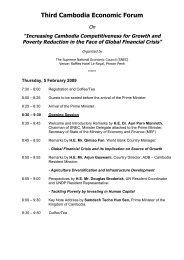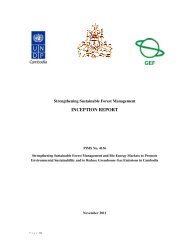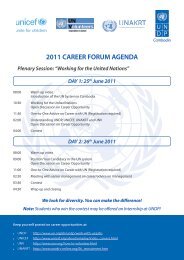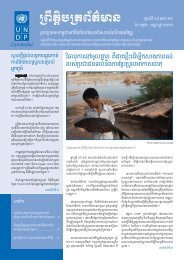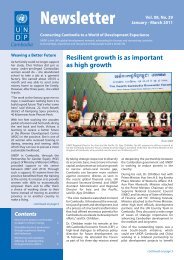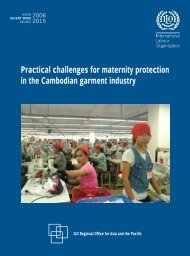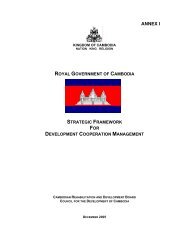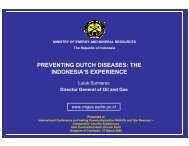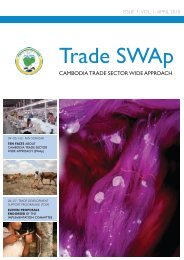UN Analysis Final.pdf - United Nations in Cambodia
UN Analysis Final.pdf - United Nations in Cambodia
UN Analysis Final.pdf - United Nations in Cambodia
You also want an ePaper? Increase the reach of your titles
YUMPU automatically turns print PDFs into web optimized ePapers that Google loves.
The national mapp<strong>in</strong>g activity of NGO and IO work found that there are significant gaps <strong>in</strong> geographical<br />
coverage <strong>in</strong> terms of density and concentration of programme and project <strong>in</strong>terventions. This suggests that<br />
despite important recent achievements <strong>in</strong> expand<strong>in</strong>g the reach of improved transport and communication<br />
networks, more distant and remote areas cont<strong>in</strong>ue to lag beh<strong>in</strong>d more accessible rural and urban areas,<br />
particularly with respect to health and education services. One reason for this is that NGOs and IOs may prefer<br />
to concentrate their efforts and resources <strong>in</strong> more accessible areas, s<strong>in</strong>ce on a per unit cost basis, it is probably<br />
more efficient to serve densely populated areas. Such a trend could also be expla<strong>in</strong>ed by Government policies<br />
that do not locate health posts and school facilities <strong>in</strong> remote areas where population is scattered. However,<br />
this will also depend on the objective of the <strong>in</strong>tervention. If the overall objective is to reduce poverty among<br />
youth, then more <strong>in</strong>terventions will have to be set <strong>in</strong> place <strong>in</strong> regions where young people are frequently<br />
vulnerable, particularly <strong>in</strong> relation to access to employment, education and health.<br />
There appears to be a time lag between <strong>in</strong>frastructure development and the target<strong>in</strong>g of development<br />
<strong>in</strong>terventions. Once road access to certa<strong>in</strong> areas has been improved, for example, it takes time to plan a<br />
particular <strong>in</strong>tervention and mobilize resources, imply<strong>in</strong>g a need for more forward-look<strong>in</strong>g <strong>in</strong>terventions<br />
that anticipate improved access. This <strong>in</strong> turn suggests the need for better <strong>in</strong>formation and coord<strong>in</strong>ation at<br />
appropriate levels of adm<strong>in</strong>istration. The Government may need to take a more pro-active role <strong>in</strong> terms of<br />
encourag<strong>in</strong>g NGOs and IOs to <strong>in</strong>tervene <strong>in</strong> poorly served areas.<br />
NGOs, IOs, and government agencies each have comparative advantages. For example, NGOs generally have<br />
an advantage <strong>in</strong> terms of their flexibility to target and contact hard-to-reach groups, while IOs may have an<br />
advantage <strong>in</strong> terms of resources and technical capacity. The Government often has an advantage <strong>in</strong> terms of<br />
the scope of <strong>in</strong>formation and coverage, access to <strong>in</strong>formation, and <strong>in</strong>stitutional mandates for action. Each of<br />
these development players needs to coord<strong>in</strong>ate and consult with one another <strong>in</strong> order to most effectively<br />
provide complementary packages of <strong>in</strong>puts and services for youth. This is important <strong>in</strong> terms of poverty<br />
reduction, as poorly-served these areas tend to have higher poverty rates than many areas that have<br />
abundant <strong>in</strong>terventions. Moreover, <strong>in</strong> light of <strong>in</strong>creas<strong>in</strong>g spend<strong>in</strong>g on health, subsidies would have an important<br />
impact on poverty reduction. In terms of target<strong>in</strong>g, education support <strong>in</strong>terventions from NGOs and IOs tend<br />
to focus on primary education than on lower and higher secondary education. This seems appropriate now<br />
because there is a real need to ensure that more students enrol <strong>in</strong> and complete primary education, which <strong>in</strong><br />
turn will stimulate more demand for lower secondary education.<br />
If youth are to become an eng<strong>in</strong>e of growth for the country, much needs to be done to ensure that their<br />
participation <strong>in</strong> community development plann<strong>in</strong>g at the village, commune, municipal, and district<br />
levels is expanded. A mechanism to ensure youths’ voices are heard <strong>in</strong> decision mak<strong>in</strong>g and development<br />
plann<strong>in</strong>g at these levels should be enshr<strong>in</strong>ed <strong>in</strong> the National Youth Policy be<strong>in</strong>g formulated by the RGC. Capacity<br />
build<strong>in</strong>g for youth <strong>in</strong> development plann<strong>in</strong>g can start at the village level by foster<strong>in</strong>g youth representation<br />
<strong>in</strong> the governance activities of the Village Development Councils, and not merely conf<strong>in</strong><strong>in</strong>g them to vot<strong>in</strong>g<br />
dur<strong>in</strong>g election periods or contribut<strong>in</strong>g their labour <strong>in</strong> the build<strong>in</strong>g of community <strong>in</strong>frastructure. With<br />
support from NGOs and IOs, the same type of political <strong>in</strong>volvement and capacity build<strong>in</strong>g should also<br />
be replicated at the commune, municipal, district and prov<strong>in</strong>cial levels, and by establish<strong>in</strong>g a village development<br />
youth council or some form of formal youth organization at all levels. In this way, youth will be able to<br />
represent themselves <strong>in</strong> governance and be tra<strong>in</strong>ed at an early age to participate <strong>in</strong> the development process,<br />
<strong>in</strong>clud<strong>in</strong>g runn<strong>in</strong>g for elective positions <strong>in</strong> government. Creat<strong>in</strong>g village-level youth associations and<br />
<strong>in</strong>corporat<strong>in</strong>g them <strong>in</strong>to commune, municipal, district and prov<strong>in</strong>cial levels can also be a big move towards<br />
real political empowerment for youth.<br />
Situation <strong>Analysis</strong> of Youth <strong>in</strong> <strong>Cambodia</strong><br />
37




